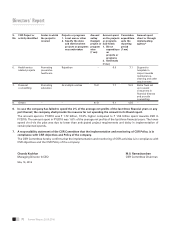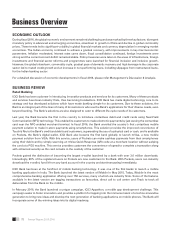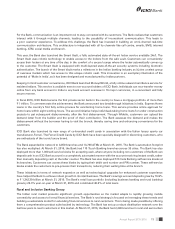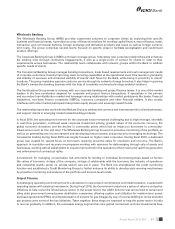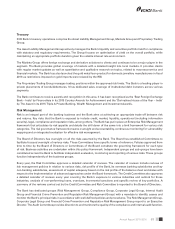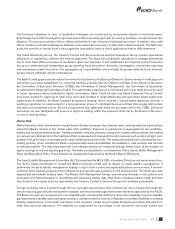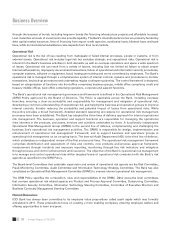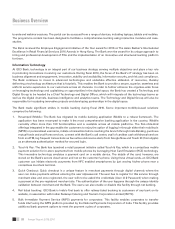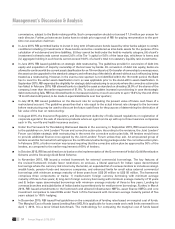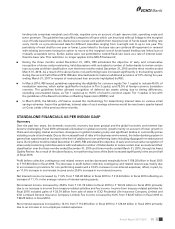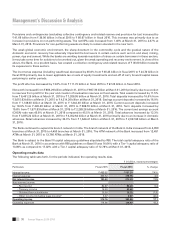ICICI Bank 2016 Annual Report Download - page 88
Download and view the complete annual report
Please find page 88 of the 2016 ICICI Bank annual report below. You can navigate through the pages in the report by either clicking on the pages listed below, or by using the keyword search tool below to find specific information within the annual report.
86
Business Overview
Annual Report 2015-2016
through the issuance of bonds, including long-term bonds (for nancing infrastructure projects and affordable housing).
Loan maturities and sale of investments also provide liquidity. The Bank’s international branches are primarily funded by
debt capital market issuances, lines of nancing from export credit agencies, syndicated loans, bilateral loans and bank
lines, while its international subsidiaries raise deposits from their local markets.
Operational Risk
Operational risk is the risk of loss resulting from inadequate or failed internal processes, people or systems, or from
external events. Operational risk includes legal risk but excludes strategic and reputational risks. Operational risk is
inherent in the Bank’s business activities in both domestic as well as overseas operations and spans a wide spectrum
of issues. Operational risk can result from a variety of factors, including (but not limited to) failure to obtain proper
internal authorisations, improperly documented transactions, failure of operational and information security procedures,
computer systems, software or equipment, fraud, inadequate training and errors committed by employees. The Bank’s
operational risk is managed through a comprehensive system of internal controls, systems and procedures to monitor
transactions, key back-up procedures and undertaking regular contingency planning. The control framework is designed,
based on categorisation of functions into front-ofce comprising business groups, middle ofce comprising credit and
treasury middle ofces, back ofce comprising operations, corporate and support functions.
The Bank’s operational risk management governance and framework is dened in the Operational Risk Management
(ORM) Policy approved by the Board of Directors. The Policy is applicable across the Bank, including overseas
branches, ensuring a clear accountability and responsibility for management and mitigation of operational risk,
developing a common understanding of operational risk; and helping the business and operation groups to improve
internal controls, thereby reducing the probability and potential impact of losses from operational risks. While
the policy provides a broad framework, detailed standard operating procedures for operational risk management
processes have been established. The Bank has adopted the three lines of defence approach for internal operational
risk management. The business, operation and support functions are responsible for managing the operational
risks inherent in the products, processes, services and activities undertaken by them. A functionally independent
Operational Risk Management Group (ORMG) is the second line of defence, complementing and challenging the
business line’s operational risk management activities. The ORMG is responsible for design, implementation and
enhancement of operational risk management framework; and to support business and operations groups in
operational risk management on an on-going basis. The Internal Audit Department (IAD) is the third line of defence,
which undertakes an independent review of the rst and second lines. The operational risk management framework
comprises identication and assessment of risks and controls, new products and process approval framework,
measurement through incidents and exposure reporting, monitoring through key risk indicators and mitigation
through process and control enhancement and insurance. The objective of the Bank’s operational risk management
is to manage and control operational risks within targeted levels of operational risk consistent with the Bank’s risk
appetite as specied in the ORM Policy.
The Board-level Committees that undertake supervision and review of operational risk aspects are the Risk Committee,
Fraud Monitoring Committee, Audit Committee and Information Technology Strategy Committee. The Bank has also
constituted an Operational Risk Management Committee (ORMC) to oversee internal operational risk management.
The ORM Policy species the composition, roles and responsibilities of the ORMC. Other executive level committees
that oversee operational risk related aspects are Product and Process Approval Committee, Outsourcing Committee,
Information Security Committee, Information Technology Steering Committee, Committee of Executive Directors and
Business Continuity Management Steering Committee.
Human Resources
ICICI Bank has always been committed to its employee value propositions called saath aapka which was formally
articulated in 2011. These propositions focus on creating a more enabling workplace, ensuring employee welfare and
offering opportunities to learn and grow.


